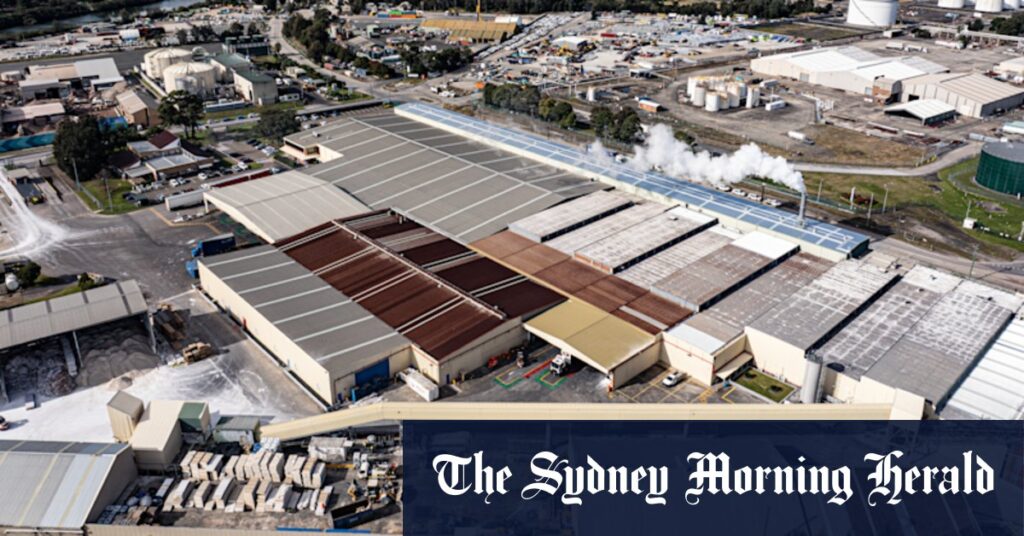The suburb of Rosehill probably has more power tools than residents. Despite being mere minutes from Parramatta CBD on the new light rail, and less than 20 kilometres from Sydney Harbour, the primarily industrial suburb was home to only 4047 people at the last census.
There was, infamously, a plan to change that: to sell the horse-racing track bordered by industrial land to the state government and allow it to build a “mini-city” of 25,000 homes on top.
But after members of the Australian Turf Club last month voted to reject that plan, Rosehill’s future remains unclear. What is the suburb like now, and where should it go next?
In its current state, Rosehill is not made for people. Bordered by Silverwater and Sydney Olympic Park to its east, the Parramatta River to its north, Harris Park to its west and the M4 to its south, Rosehill (and Camellia, the sliver of a suburb directly next to it) is almost entirely zoned “E5”: heavy industrial.
The heaviest – a crude oil refinery – has since disappeared, but there’s still work going on: building company James Hardie’s site is opposite the racetrack and the new light rail depot, with other warehouses and a recycling facility nearby.
It has been like this for a while. The region, which in colonial times was named for the Macarthur family’s Elizabeth Farm, has been used for industrial purposes since at least the 1880s, the same time as the racecourse was first established with a small “township” next door.
That long history presents a significant challenge for anyone seeking to transform the area: the soil is highly contaminated. The Herald revealed in 2021 that taxpayers were due to spend more than $100 million remediating soil where the new light rail track would go, with asbestos, hexavalent chromium and volatile chlorinated hydrocarbons all in the ground.
Loading
Remediating the soil across the whole area would be so costly as to be possible only with the returns from a very high-density site, said Eamon Waterford, chief executive of urban think tank Committee for Sydney, which has analysed the state’s policy on industrial land use.
From industrial to residential
The now-defunct Greater Cities Commission – then Greater Sydney Commission – unveiled NSW’s “retain and manage” approach towards industrial land in 2018. If all of Sydney’s industrial land were removed for housing, then jobs and essential services (from food warehouses to construction) would continue to move further away from homes, slowing down the city and its people, it said.
The vast majority of the land is zoned for industrial use.Credit: Nick Moir
“This is a tension. This isn’t a binary black-and-white … housing-or-industrial land,” Waterford said. “We need both. We have to be mature enough to be balancing things in a way that often means trade-offs and compromises.”
Residential developments will always make more money than industrial warehouses, so comparing the two is “not a fair fight”, he said. But the value of industry, including that of Rosehill, isn’t in the land itself but in the wave of effects from warehouses and delivery points being close to where people live.
Push for a master plan
Across James Ruse Drive, a handful of apartments has been erected since 2016. But what should happen to the rest of the land?
Parramatta’s mayor, Liberal councillor Martin Zaiter, is still pushing for a radical change in the area despite the failure to sell the racecourse. He says the state government’s 2022 plan for the area – which never made it to a rezoning proposal despite promising to do so by November 2023 – should be revisited and expanded.

Across the busy James Ruse Drive, the suburb has become home to several new apartment blocks that loom over single-storey houses.Credit: Nick Moir
Those plans promised a “thriving town centre with an 18-hour entertainment precinct”, 10,000 new homes and a “potential new public school”.
“We are very keen to move forward with that, so why do we not evolve the strategy into a master plan and let’s work together [with the state government] to create this,” he said, also pleading with the state government to keep the metro station (Premier Chris Minns said it would go in only if the ATC sold the land).
In its large vision document for its area by 2050, the City of Parramatta plans for the area of Rosehill-Camellia to be a “model city district”, the country’s first city to meet every one of the 17 United Nations Sustainable Development Goals.
Loading
But Waterford, who said he believes in this specific instance that the benefits of new housing in the area outweigh the benefits of retaining industrial land, is less hopeful of change.
“Without a metro station, it’s unlikely anything will happen in the future,” he said. And a metro happens only if the racecourse goes.
“If we are really serious about this, and we really think there is strategic merit to this, I think the government should be thinking about compulsorily acquiring the site.”
The Sydney Morning Herald has opened its bureau in the heart of Parramatta. Email parramatta@smh.com.au with news tips.
Read the full article here


